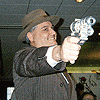
A new aircraft in the Flying Bulls’ stable
It set new standards in military aviation and was hugely popular in the US Air Force: the Lockheed P-38 Lightning. In the Second World War, the fighter bomber was noted not only for its tri-fuselage construction, but also for its highly successful missions. More than 70 years after they were created, there are only a few P-38s still taking majestically to the skies – and since the beginning of March 2009, one of them has its home in Salzburg.
On Monday, 9 March 2009, a revered piece of US aviation history landed in Salzburg. There are only a handful of the famous P-38 Lightnings still intact, and one of them has adopted Hangar-7 as its base. The aircraft, which was produced at the Lockheed workshops, is hugely valued by aircraft enthusiasts and will from now on be flying under the Red Bulls’ sun. It has already seen many exciting adventures: for example the journey from the American mainland to Salzburg, which, contrary to the aircraft’s name, did not take place “at lightning speed”, but was a costly and laborious undertaking.
“Our journey here was long and full of incident, but eventually we arrived at our new home base safely and without problems,” relates pilot Sigi Angerer. Although it would have been technically possible to fly over the North Atlantic, the advanced age of the aircraft made this too risky. So the decision was taken for the aircraft (which has since been licensed for civil flights) to be shipped from continent to continent – and in one piece.
There were not just the bureaucratic obstacles to be overcome. After the P-38 had taken off from Texas, it made an intermediate landing in Pensacola, Florida. From there it was taken by road over the last few kilometres to the port. Several times, the Lightning had to be lifted by mobile crane over road sections which were too narrow. Finally it left American soil – again by crane – and disappeared into the steel bowels of the “Flintereems”.
Crossing the Gulf of Mexico, with an intermediate stop in the Caribbean, the journey continued over the Atlantic, past the Azores and through the English Channel to Rotterdam. The P-38 reached terra firma for the first time at the port of Hamburg, and got its first breath of European air on 6 March. Although the journey by ship had taken a long time, the crew were never bored. Stormy seas meant that the lashing straps in the hull of the ship had to be checked and adjusted every day to ensure safe transport of the aircraft.
In Hamburg, Sigi Angerer was finally able to press the start buttons on the two Allison engines and continue the journey, not at around eleven nautical knots (= 20 km/hour) but at up to 500 kilometres per hour: the P-38 was finally in its true element, the air. Because of changeable weather conditions, landing at the new base had to be deferred several times. Thus it was less than two hours, including the intermediate landing in Oberpfaffenhofen, before this proud flying machine spread its extraordinary wings over the city of Salzburg and finally turned to land safely in front of Hangar-7, where it touched down at precisely 5:32 pm to huge applause from the Flying Bulls crew.
Category All / All
Species Unspecified / Any
Size 1280 x 848px
File Size 91.8 kB
Aha! Thanks for clearing that up. I still have yet to see a P-38 in flight at full speed, but my dad mentioned that the "Lightnings" would whistle like a jet fighter as they flew by. This was late in WW II in the Pacific theater, and my day mentioned he believed this noise was caused by the turbochargers of both engines.
Anyway, there's always been a "Soft Spot" in my head for the P-38.
Anyway, there's always been a "Soft Spot" in my head for the P-38.
This was "Lefty" Gardener's old P-38J, with the P-38E Intakes, for aerodynamics. Lefty died, and the formerly Red, (Mostly )White, and blue airshow perennial was sold and has left the U.S.a. Sorry to see it leave the continent, but after glacier Girl's restoration, we have a P-38E doing the air show circuit inthe U.S. again.
having the Two Stage supercharger is what made that plane into an "interceptor". That same Allison 1720 engine was used for the Bell P-39 Airacobra, and the P-51A (Mustang Mk. I)/ A-36 Apache, but without the two stage, and only a single stage, and it had a lot less performance at higher altitudes, because of that. Now, that P-38 isn't needing to cruise at 16,000 ft., for hours at a time over a flight of B-17's, the supercharger becomes superfluous equipment.
I read an article once that said Charles Lindbergh was actually pressed into service during WWII to prove to the pilots in the Pacific theater that they could fly to and from battle with the engines on a super lean fuel mixture. The dangers of this were an increased exhaust temperature and cylinder detonation (ping) where the gas mixture explodes rather than burns. This lean mixture was meant to give them much more range.
V.
V.

 FA+
FA+













Comments